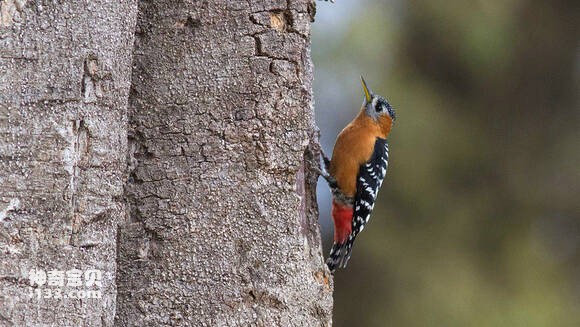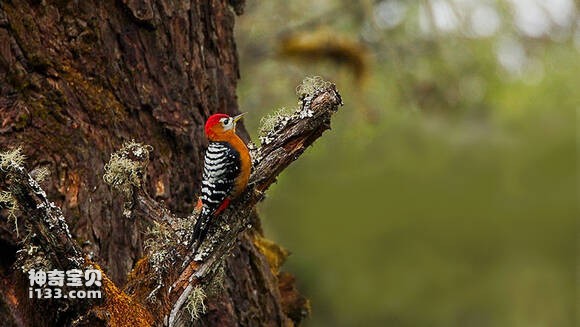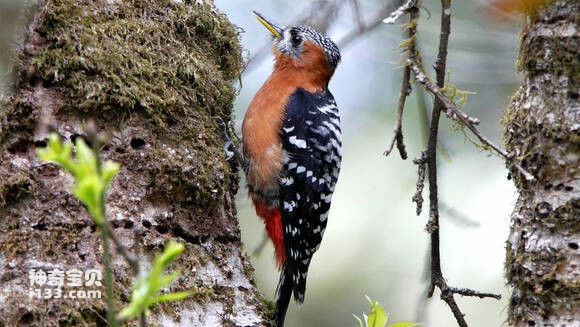Dendrocopos hyperythrus
IUCN
LCBasic Information
Scientific classification
- name:Dendrocopos hyperythrus
- Scientific Name:Dendrocopos hyperythrus,Rufous-bellied woodpecker
- Outline:Climbing birds
- Family:
Vital signs
- length:18-23cm
- Weight:41-65g
- lifetime:No textual research information is available
Feature
It's a brightly colored woodpecker
Distribution and Habitat
It is found in Bangladesh, Bhutan, China, India, the Lao People's Democratic Republic, Myanmar, Nepal, Thailand, and Vietnam.
The brown-bellied woodpecker is found in China from southeast Tibet to northwest, west and south Sichuan and Yunnan, and migrates vertically at altitudes of 1500-4300 m. It is distributed in most areas of Yunnan, mainly in secondary broad-leaved forest, mixed coniferous forest and fir moss forest. Single and pair activities. Eat insects as a staple food. The Tibetan subspecies breeds in western Tibet; The named subspecies is found from southeastern Tibet to northwestern, western and southern Sichuan and Yunnan, and migrates vertically at altitudes of 1500-4300 m. The common subspecies breeds at mid-altitude in Heilongjiang and overwinters through eastern China to southern China. Prefers coniferous or mixed forests.
Appearance
The brown-bellied woodpecker is 17-20 cm long and weighs 25-35 g. Dark red on top of head and neck; The back is black and white stripes; Waist to central tail feathers black; Lateral pair of tail feathers white with black stripes. The eye line and chin are white, and the rest of the lower body is mostly pale ochre color, only the tail undercover feathers are pink. The small overlying wings are black, the rest of the wings are mostly black with white spots, and the inner three flight feathers have white stripes. The top of the female's head is mixed black and white.
The brown-bellied woodpecker is a brightly colored woodpecker. The back, wings and tail are black, with rows of white spots; Thick russet brown on the side of the head and the lower body is the distinguishing feature of this species. Red buttocks. Red crown and pillow of male bird. The female has a black crest with white spots. Tibetan subspecies has red occipital extension behind ear feathers; The named subspecies h
Details
The brown-bellied woodpecker has four subspecies, Dendrocopos hyperythrus and Rufous-bellied woodpecker。

Brown belly woodpecker sounds is elongated syllable kii break - I - I - I - I - I - I even call, more and more weak to end; Similar to the great spotted woodpecker, but mostly found in the mountains. Sexual shyness; Migrations often fly alone. The call is also similar to that of the great spotted woodpecker, but not very vocal. Both male and female chisels are silent。

Woodpeckers eat insects, especially ants, but also bug Elephants-Are-Endangered.html">elephants, weevil, lepidoptera larvae, walking insects.

The breeding season of the brown-bellied woodpecker is between April and June. The nest is located in a hole in a decayed or semi-decayed tree trunk, about 3-5 meters from the ground. It can sometimes take up to a month to make a hole. Its holes are slightly oval in shape, rather than rounded like those of other woodpeckers. There are usually 3 eggs per birth, but rarely only 2 or more than 4 eggs. The average size of the 15 eggs was 22.2×16.5 mm. The male and female incubate the eggs in turn, and the chicks become late sex.
It was included in the List of Beneficial Terrestrial Wildlife under State Protection or of Important economic and scientific research Value issued by the State Forestry Administration of China on August 1, 2000.
Listed on the International Union for Conservation of Nature (IUCN) 2012 Red List of Threatened Species ver3.1 - Not Threatened (LC).
Protect wild animals and eliminate wild meat.
It is everyone's responsibility to maintain ecological balance
!








